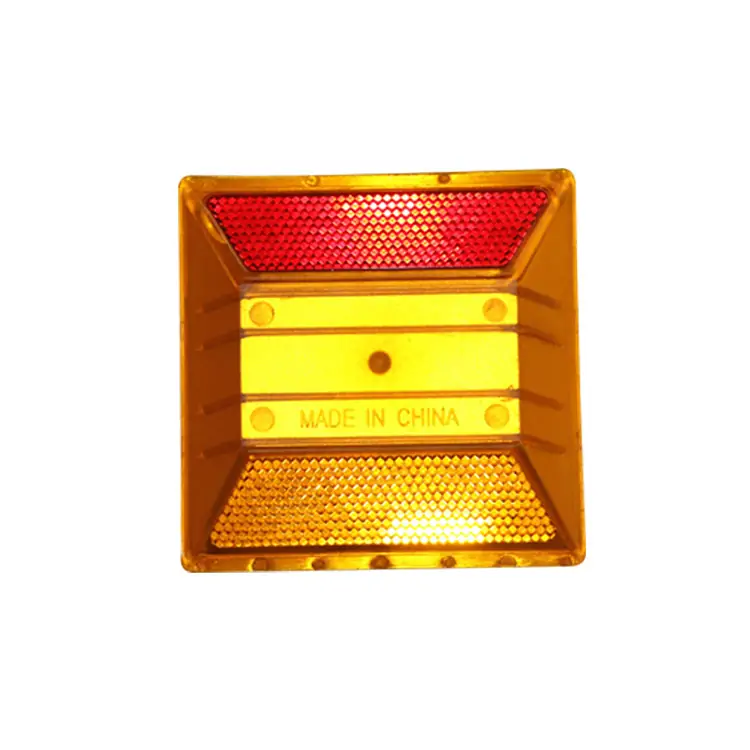Reflective road markers play a crucial role in promoting safety and efficient traffic flow in work zones and construction areas. These markers help guide drivers, delineate lanes, and provide important visual cues, which are particularly critical in areas with changing road conditions. Here’s how reflective road markers are used in work zones and construction areas:
- Lane Delineation: Reflective road markers are often used to mark lane boundaries in construction zones. They help drivers maintain proper lane discipline, preventing lane drift and potential collisions.
- Lane Shifts and Merging: In work zones where lanes may shift or merge, reflective road markers guide drivers to the correct lane or the point of merging. They provide clear visual cues, reducing confusion and enhancing traffic flow.
- Advance Warning: Reflective road markers are employed to provide advance warning to drivers about upcoming changes in road conditions. They can mark areas where lanes narrow, or where the roadwork begins.
- Separation of Traffic: In some work zones, traffic needs to be separated. Reflective road markers are used to create a physical barrier, such as temporary medians, to separate lanes of traffic.
- Detour Routes: Reflective road markers are instrumental in marking detour routes during construction. They guide drivers along alternative routes to navigate around the work zone efficiently.
- Pedestrian Safety: Reflective road markers can also be used to mark pedestrian crosswalks and zones within construction areas. This enhances pedestrian safety and ensures drivers are aware of pedestrian right-of-way.
- Visibility in Low-Light Conditions: Reflective road markers remain highly visible during low-light conditions, such as nighttime, fog, or rain. This visibility is critical in ensuring the safety of drivers and workers in construction zones.
- Temporary Work Area Organization: Reflective road markers help organize and define the boundaries of temporary work areas, reducing the likelihood of accidents and improving the safety of construction workers.
- Warning for Hazards: Reflective road markers can be used to warn drivers about specific hazards within work zones, such as equipment, materials, reflective road marker or uneven road surfaces. They create a visual buffer, prompting drivers to exercise caution.
- Temporary Signage Mounting: Reflective road markers can hold temporary regulatory signs, warnings, and directional signs to provide additional information to drivers about the work zone, speed limits, or other important instructions.
- Emergency Egress: In the case of an emergency, reflective road markers can mark emergency egress routes, enabling drivers to exit work zones safely.
Reflective road markers are essential tools in work zones and construction areas, as they provide continuous and highly visible guidance for drivers. They contribute to the safety of both drivers and workers while ensuring that traffic flows efficiently through changing road conditions.
How are reflective road markers utilized to delineate lanes and guide drivers on highways and urban roads?
Reflective road markers are essential for delineating lanes and guiding drivers on highways and urban roads. They help maintain order, enhance safety, and reduce the risk of accidents. Here’s how reflective road markers are utilized for this purpose:
- Lane Delineation: Reflective road markers are placed along the edges of lanes to clearly define their boundaries. This visual cue helps drivers maintain proper lane discipline and reduces the risk of lane drifting or inadvertent lane changes.
- Centerline Marking: On two-lane highways and roads, reflective road markers mark the centerline, providing drivers with a clear reference for staying within their lane and preventing head-on collisions.
- Lane Changes: Reflective road markers are strategically positioned in areas where lane changes are allowed. They guide drivers as they transition from one lane to another, enhancing traffic flow and safety.
- Turn Lanes: Reflective road markers indicate the presence of turn lanes, such as left-turn or right-turn lanes. They help drivers safely navigate intersections and make appropriate turns.
- Multi-Lane Roads: Reflective road markers are critical on multi-lane roads and highways, where they indicate the presence of multiple lanes, making it easier for drivers to choose the correct lane for their intended exit or direction.
- Exit Ramps and Entrance Ramps: Reflective road markers are used to define the edges of exit and entrance ramps on highways. They provide guidance to drivers as they enter or exit the highway.
- Curve Warnings: In areas with curves or bends in the road, reflective road markers may be placed in a specific pattern to warn drivers of the upcoming curve. These markers provide a visual cue that encourages drivers to reduce speed and navigate the curve safely.
- Intersection Safety: Reflective road markers are often used to delineate lanes and provide guidance at intersections. They indicate which lanes are for going straight, turning left, or turning right, reducing the potential for confusion and conflicts.
- Pedestrian Crossings: In urban areas, reflective road markers are used to delineate pedestrian crossings and crosswalks, making them more visible to drivers and enhancing pedestrian safety.
- Cyclist Lanes: Reflective road markers are employed to designate dedicated lanes for cyclists, helping protect cyclists and minimize interactions with motor vehicles.
- Visibility at Night and in Low-Light Conditions: The reflective properties of these markers make them highly visible at night or during adverse weather conditions. They reflect the headlights of approaching vehicles, improving visibility for drivers.
- Speed Control: Reflective road markers can be strategically placed to indicate changes in speed limits, such as in school zones or construction zones, prompting drivers to reduce their speed.
Overall, reflective road markers are indispensable tools for traffic management on highways and urban roads. They help drivers navigate roadways safely and efficiently by providing clear lane delineation and guidance, especially in low-light conditions.
